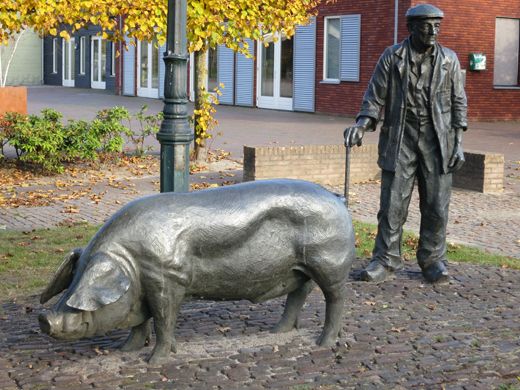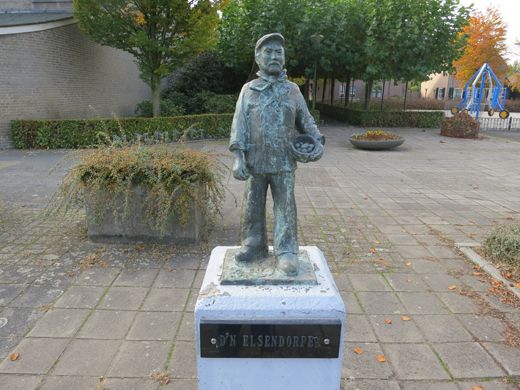The villages in Gemert-Bakel
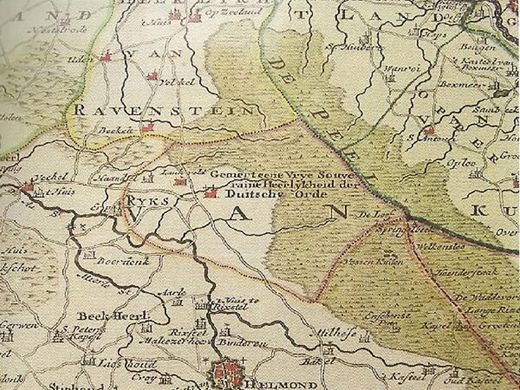 De Heerlijckheid Gemert-Bakel consists of 7 church villages: Gemert, Bakel, De Mortel, Handel, Elsendorp, De Rips and Milheeze. Each village has its own rich history. Each village here is unique. Click here for a short introductory film about Gemert-Bakel:'Kom ook naar Gemert-Bakel'. It is definitely worthwhile to come and visit the church villages. For a day out, a weekend trip or an overnight stay in nature. In Gemert-Bakel there is plenty for adults and children to see, do and experience.
De Heerlijckheid Gemert-Bakel consists of 7 church villages: Gemert, Bakel, De Mortel, Handel, Elsendorp, De Rips and Milheeze. Each village has its own rich history. Each village here is unique. Click here for a short introductory film about Gemert-Bakel:'Kom ook naar Gemert-Bakel'. It is definitely worthwhile to come and visit the church villages. For a day out, a weekend trip or an overnight stay in nature. In Gemert-Bakel there is plenty for adults and children to see, do and experience.
Gemert
Gemert is an urbanized village in the municipality of Gemert-Bakel, located in North Brabant. Until the municipal redivision in 1997, it was an independent municipality.
The core of Gemert is Ridderplein and its surroundings. On this is the castle and more to the north the church of St. Jans Onthoofding. On this square is also located the town hall, a number of cafes and restaurants. On the main streets (ribbon development) leading to the Ridderplein are many stores. Gemert therefore functions as a regional center. To the west, there has never been much new construction, so one can quickly reach the outlying area via the road next to the castle or even via the old streets leading west. Many historic buildings can still be found on the original streets.
To the east, in addition to a few older streets, are new housing developments. Between the houses flows the Rips River, which, however, is hardly noticeable in the bowl of Gemert.
Bakel
The oldest village in southeastern Netherlands
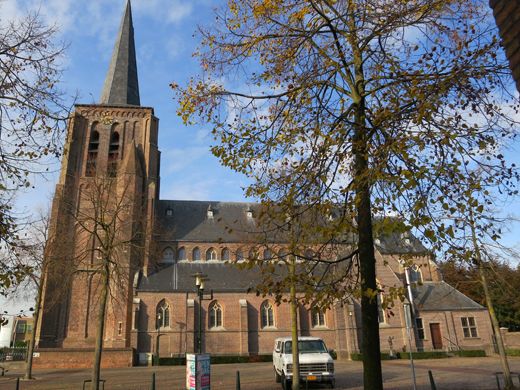 Bakel is almost the oldest village in the Netherlands but at least the oldest village in Southeast Netherlands. In fact, in 2014 it officially turned 1,300 years old. The first mention dates back to 714 AD, but Bakel thus existed before that. How much earlier is not known.
Bakel is almost the oldest village in the Netherlands but at least the oldest village in Southeast Netherlands. In fact, in 2014 it officially turned 1,300 years old. The first mention dates back to 714 AD, but Bakel thus existed before that. How much earlier is not known.
Bakel was located on the old thoroughfare from Empel to Roermond on a road also called the Oudestraat (prehistoric route Empel-Roermond). The oldest written mention dates back to the year 714, when a charter was drawn up for the Frankish mayor Pippin II in his residence in Bakel ("Bagoloso" in those days). This early-medieval royal residence has not yet been located archaeologically. A charter from 721 speaks of the possessions of the Frankish nobleman Herelaef, whose mother had possessions at Bakel (Baclaos). In that year Herelaef donated to Willibrordus, among other things, a church at Bakel. Through Willibrordus, this church came into the possession of the Abbey of Echternach, which would continue to have influence in Bakel until 1795. The authenticity of the original documents, the originals of which had generally been lost by the 11th century, is doubtful. They rest on the Liber Aureus written by interested monks.
Before 721, a wooden church was built in Bakel, which was replaced by a stone Romanesque church around 1100. This was in turn replaced by the present, Gothic, church. The parish church of Bakel was the mother church for the inhabitants of Deurne, Gemert and Milheeze.
Several successive popes ratified the rights of the Abbey of Echternach. Around 1100, the possessions of this abbey were administered by a laatbank established in nearby Deurne.
In the subsequent period, feudal lords began to exhibit increasing power. Around 1200 Bakel fell under the County of Rode which was under the influence of the Count of Gelre. William I of Horne owned the guardianship of the goods of the Abbey of Echternach in Peelland and transferred them to Duke Henry I of Brabant in 1222. However, the cijns' right was shared between duke and abbey. However, the abbey reissued the tithe right to local notables.
In 1648, Bakel came directly under the Republic of the Seven United Netherlands and the practice of the Catholic religion was prohibited. From 1672-1674, the region was occupied by French troops. Barn churches could be built from then on, and the Bakel barn church remained in use until 1818, after which the Catholics regained their original church.
De Mortel
De Mortel is a church village of the municipality of Gemert-Bakel in North Brabant.
As in many Brabant villages, in De Mortel the 1904 church is iconic. Along the thoroughfare is a statue depicting the Mortel pig farmer, "The Bear Leader. This statue is one of the many creations of the Gemert artist Toon Grassens. The built-up area is announced with a sign bearing the motto 'De Mortel a (h)real village'.
Many activities take place on the village meadow with an octagonal kiosk on top. De Mortel is surrounded by an agricultural cultural landscape with forests, fields and stream valleys. There are numerous bicycle and hiking trails. The "Mortels ommetje" is a bicycle route through the village and the outlying area.
In the woods of De Mortel on the Hemelsbleekweg stands a 128-meter tower of KPN nicknamed "The Root of De Mortel. The tower is also known for its breeding peregrine falcons, which can be followed via a camera.
Handel

Handel is a village in the province of North Brabant. It belongs to the municipality of Gemert-Bakel. Handel is the oldest Marian place of pilgrimage in North Brabant. Its history goes back to 1368. Possibly the devotion dates from even earlier times, but in a fire in 1709 the archives were lost, so nothing can be traced with certainty. Thousands of visitors come every year.
Behind the church is a processional park, in which lies the "miraculous well," whose water is said to have medicinal properties. Another legend says that the statue of Mary that is in the church was found in a tree. This so-called "Marian tree" was struck by lightning and split open. The statue of the Virgin Mary was then found in the middle of the tree. The now dead Marian tree still stands in the forest.
One of the best-known and largest pilgrimages to Handel is the Handel Procession, which is made on foot from Valkenswaard by approximately one thousand pilgrims each year. This procession also leads along the Kèskesdijk. This road that leads from Gemert to Handel is flanked by seven kèskes, which are small chapels with a niche. In it there is a group of statues that always refer to one of the Seven Sorrows of Mary.
Elsendorp
Elsendorp is a reclamation village in the municipality of Gemert-Bakel, province of North Brabant. At the end of the nineteenth century, the municipality of Gemert sold much of the heathland in its possession to mainly Protestant capital owners who had the heathland reclaimed, usually by the Heidemij, into forest and agricultural land.
One of these individuals was Samuel Cornelis van Musschenbroek, who founded the Maatschappij tot Ontginning van de Peel and in 1891 founded two model farms at the site of present-day Elsendorp. One of them was called De Dompt and this was also the original name for the reclamation village.
At the junction of the road between Gemert and Oploo and the road to De Rips, a number of middlemen settled in the early twentieth century. A public school was also founded here in 1925, which was converted into a Roman Catholic school in 1935. In 1926, a Roman Catholic emergency church was founded and the village was named after Father Gerlachus van den Elsen. Because the name Van den Elsendorp was considered too long, it became Elsendorp. The emergency church was dedicated to St. John Evangelist. To finance the construction of a new church, the building pastor of Elsendorp, Rector Busscher, organized car blessings. These continued even after the church was completed and gave Elsendorp national fame in the 1960s.
The present church is a creation of Herman Reuser of Nijmegen. It was consecrated on May 15, 1960, and it is dedicated to St. Christopher, who is patron saint of road users. The church contains chapels for Our Lady of Perpetual Help, St. Christopher and the Sacred Heart. There is a Christoffel statue by Gerard Bruning, a baptismal font crafted by Jan van Gemert and stained glass windows by Ton Frenken and Frans Smeets.
De Rips
De Rips is a reclamation village in the municipality of Gemert-Bakel in North Brabant. The history of habitation in the area goes far back, as objects from the Tjonger culture were found.
The parish of De Rips was founded in 1921. You will find many characteristic forest workers' houses, larger farms in a different architectural style and Ripse panels in the Forest Museum, which depict the history of De Rips. The forest area of De Rips is a must for the true lover of nature and history.
The Pioneer, a bronze statue of a worker performing reclamation work. It is located in front of the MFA D'n Eik.
Chapel Mary of Charity, an octagonal and slate-covered building from 1994, on the Middenpeel Road. The chapel has a beautiful wrought iron entrance gate and paintwork. The establishment of this chapel was a private initiative of the Ploegmakers family. A small exhibition was set up in the nearby barn of their farm. Mrs. Ploegmakers is said to have had a vision of the chapel in 1990.
The Forest Museum, near the Beestenveld parking lot, shows the rich history of the Peeldorp through information panels and visual materials.
Milheeze
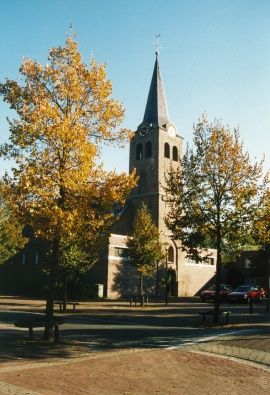
Milheeze (dialect: Millus) is a village in the Dutch province of North Brabant that has belonged to the municipality of Gemert-Bakel since 1997. The first mention of Milheeze dates back to 1334, when the name was spelled Milhese. In 1440, when the chapel was founded, it was already written Milheeze, and Milheze also occurred. The name hees refers to low shrubbery, think shrubbery. The origin of the prefix mil is not known. Previously, the name was also explained from middel and heeze would mean forde or ford. However, namerically this theory cannot be substantiated.
The mill Laurentia is an eight-sided corn mill that was rebuilt in Milheeze in 1890 and had previously served as a polder mill in Bleskensgraaf. It stands on the road to Bakel, almost at the location of the Peelrand fault.
St. Willibrordus Church has a tower dating from the early 15th century. The tower has three tiers. The bell holes are decorated. Around 1900 the tower was raised by several meters and in 1964 the church was further expanded with a rectangular extension. The 15th century Marian bell disappeared at that time. The current bells date from 1948. In 1897 the church received a Smits organ that had previously served in another church and had to be reduced in size to fit in the Milheezer church.
Marian chapel from 1938, built on the occasion of the 40th anniversary of the priesthood of pastor J. Simonis. It is a small square building open on three sides with bluestone pillars and round arches. It was built in the Delft School style and made of imitation hand-formed brick. The chapel has a slate-covered gable roof and it contains a statue of the Virgin Mary. The chapel stands slightly east of the windmill, on the road to Bakel.


